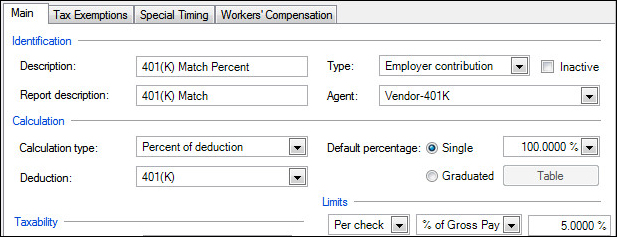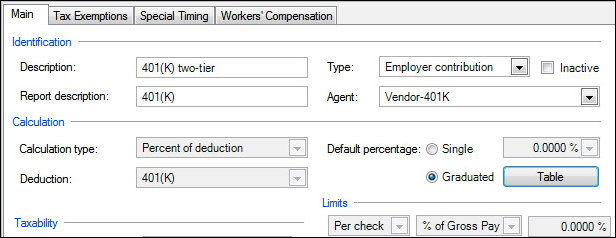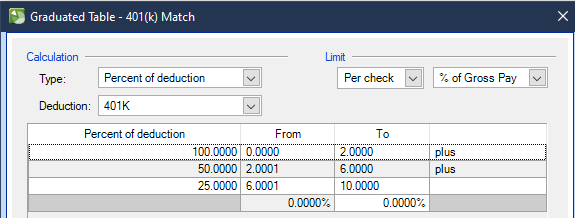We moved!
Help articles have been migrated to the new Help and Support. You can find help for your products and accounts, discover FAQs, explore training, and contact us!
The examples in this article are common scenarios for employer contributions, and can be used for both live and after-the-fact payroll processing.
The examples assume that you have already set up a deduction item for the employee's contribution.
Example 1: Company match with a percentage limit
Makayla's company will match 100% of her contributions, up to 5% of her salary.
- Choose Setup > Payroll Items.
- Add a new payroll item, and enter a description.
- In the Type field, select Employer Contribution.
- In the Calculation type field, select Percent of deduction and select the employee deduction item in the Deduction field.
- In the Default percentage field, select Single and enter 100%.
- In the Limits section, select Per check, % of Gross Pay, and 5%.

Example 2: Company match with an amount limit
Carter works for a small business that just started a company match program. They’ll match up to 50% percent of his contribution with a $100.00 limit each weekly paycheck.
- Choose Setup > Payroll Items.
- Add a new payroll item, and enter a Description
- In the Type field, select Employer Contribution.
- In the Calculation type field, select Percent of deduction.
- In the Default percentage field, choose Single and enter 50%.
- In the Limits section, select Per check, Amount, and $100.00.

Example 3: Company match with two-tier percentage limits (requires graduated table)
Harper’s company wants to encourage 401K saving; however, they need to break their match into a two-tier level to calculate the contribution based on:
- 100 percent of the employee's 401(k) deduction, up to 3 percent of the current check gross pay amount.
- and 50 percent of the employee's 401(k) deduction, up to 5 percent of the current check gross pay amount.
- Choose Setup > Payroll Items.
- Add a new payroll item, and enter a description.
- In the Type field, select Employer Contribution.
- In the Calculation type field, select Percent of deduction, and then select the employee deduction item in the Deduction field.
- In the Default percentage field, select Graduated and click the Table button.

- Set up the graduated table in the following way.

In this example, let's assume that the employee's gross pay is $1000.00 and their 401(k) deduction is $100.
(Note that the maximum employer contribution amount that it can calculate is $50.00, because the maximum limit is 5%, and 5% of $1,000.00 gross pay is $50.00.)
- First, Accounting CS takes 100% of the 401(k) deduction ($100.00) with a limit of up to 3% of gross pay (1000 x .03 = $30) and it calculates $30.00 for that portion, due to the limit.
- Next, it uses 50% of the remainder amount to calculate the second tier. So, $50.00 (maximum amount) - $30.00 (first tier amount) = $20.00 (remainder amount). 50% of $20.00 = $10.00.
- Accounting CS then calculates the employer contribution amount as $40.00. $30.00 from the first tier calculation + $10.00 from the second tier calculation = $40).
See also:
Example 4: Company match with 3 tiers
Sam's company wants to match their employees' 401K contributions as much as they can. They have a three-tier matching level calculation based on:
- 100% of the employee's 401(k) deduction, up to 2 percent of the current check gross pay amount.
- and 50 percent of the employee's 401(k) deduction, up to 6 percent of the current check gross pay amount.
- and 25 percent of the employee's 401(k) deduction, up to 10 percent of the current check gross pay amount.
- The maximum deduction amount for employees is $70.
- Choose Setup > Payroll Items.
- Add a new payroll item, and enter a description.
- In the Type field, select Employer Contribution.
- In the Calculation type field, select Percent of deduction, and then select the employee deduction item in the Deduction field.
- In the Default percentage field, select Graduated and click the Table button.

- Set up the graduated table in the following way.

In this example, let's assume that the employee's gross pay is $1,000.00 and the employee takes a 401(k) deduction of the $70 maximum.
(Note that the maximum employer contribution amount that it can calculate is $100.00, because the maximum limit is 10%, and 10% of $1,000.00 gross pay is $100.00.)
- First, Accounting CS takes 100% of the 401(k) deduction ($70) with a limit of up to 2% of gross pay (1000 x .02 = $20) and it calculates $20 for that portion.
- The next limit is $60 (1000 x .06 = $60), but we already matched $20, so $40 are left. The second tier matches half of this, so the match is another $20.
- The final limit is $100 (1000 x .1 = $100), and with the already matched amounts, we're left with $40 maximum to match ($100 - $20 from the first tier - $40 from the second tier = $40). However, this exceeds the employee deduction limit of $70, so the match amount is reduced to $30. 25 percent of the remaining $30 is $7.50.
- The employer match is $47.50 ($20 from first tier + $20 from second tier + $7.50 from the third tier).
Was this article helpful?
Thank you for the feedback!



